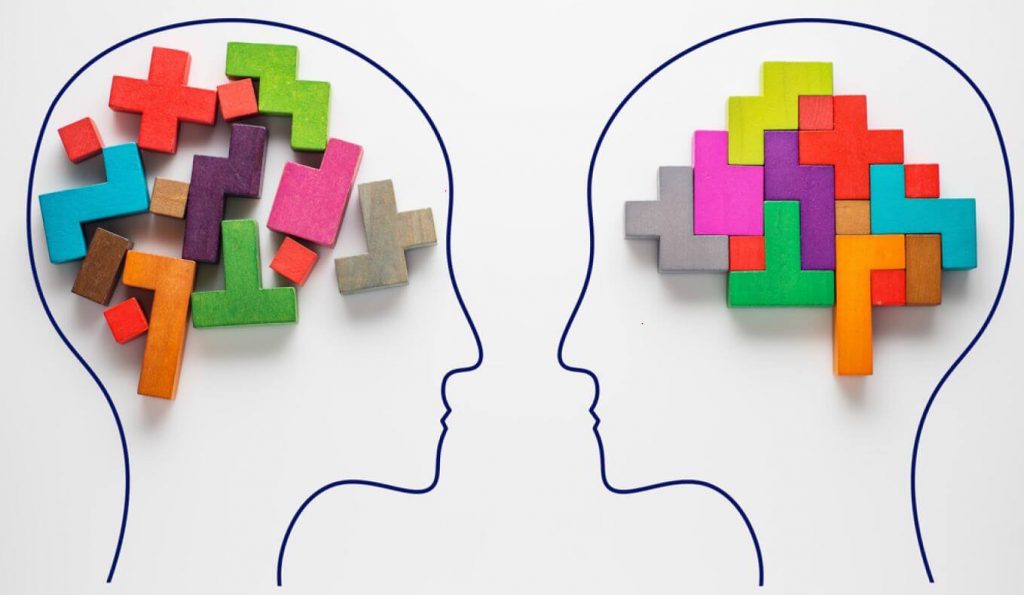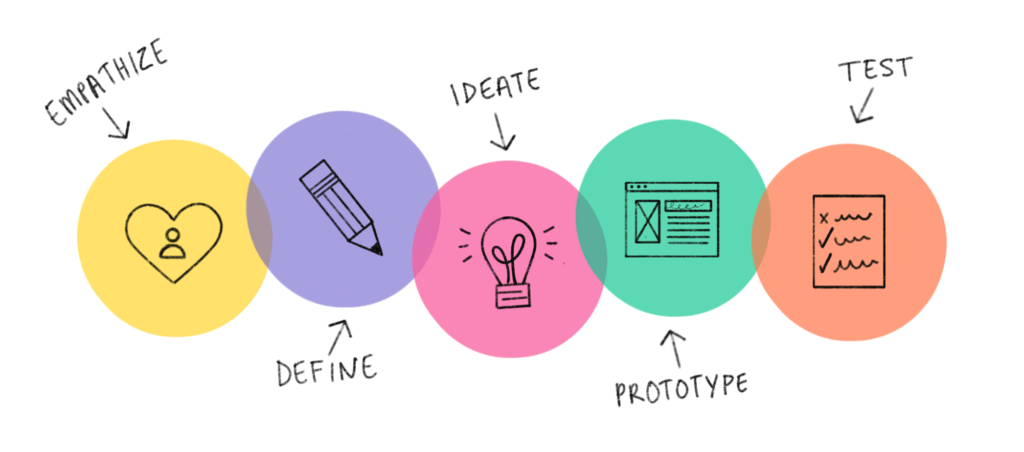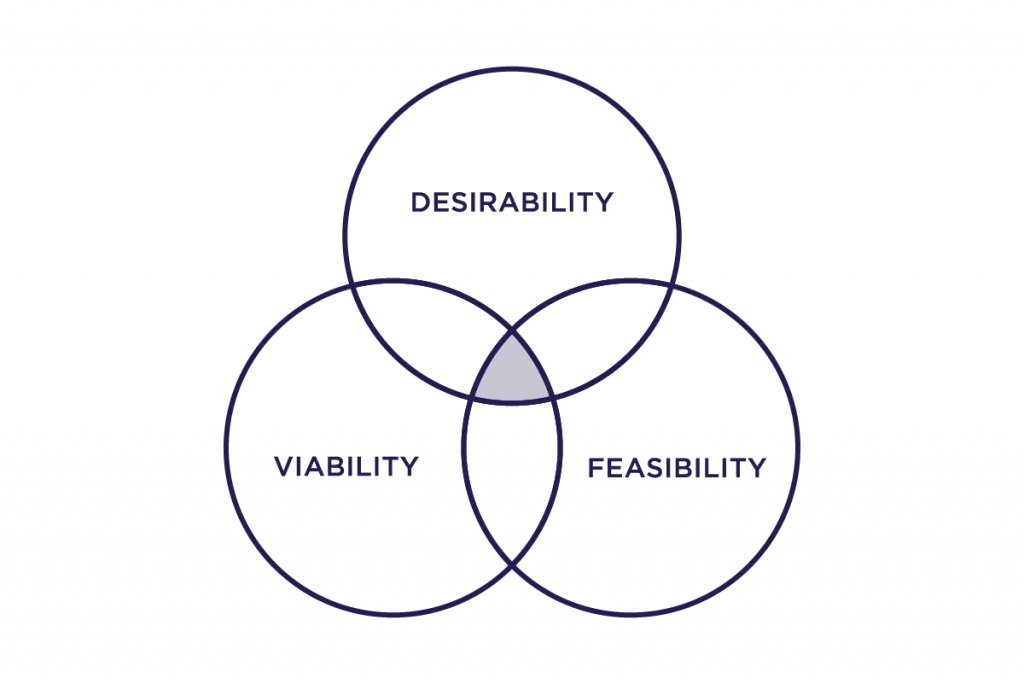Guide to Design Thinking: The Key to Innovation
Let us begin with the most intriguing question – what is design thinking? My friends, it is an effective method of creative problem-solving. This means developing new ideas to solve complicated problems and meet user needs.
Do you still need clarification? Don’t worry; I will explain it step by step.
Design thinking is a process that involves understanding users, defining problems, generating possible solutions (ideas), building prototypes and testing them out on people who might use them. It’s iterative, too – so you go through these stages repeatedly until something works!
Seems like a lot, doesn’t it? But believe me when I say this: if appropriately used in creating products/services/ experiences that truly connect with your audience – IT CAN CHANGE EVERYTHING!
Table of Contents
The Five Stages of Design Thinking

Now let us delve into the specifics of the design thinking process:
- Empathise: This is where you would be like Dr Phil and try to understand deeply what your target users need and feel and where they are coming from. What matters most is watching people do stuff (observation) and asking them questions about what they want or don’t want, why they do things, etc., basically listening well.
- Define: Once valuable insights have been gathered, it becomes necessary to define clearly what problem needs solving. Doing this helps concentrate efforts to stay aware of the situation.
- Ideate: Time for some wild thinking! Aim to generate numerous ideas during this phase, even if they seem crazy. Brainstorming can also help mind mapping; doodling may trigger those ‘aha’ moments.
- Prototype: At present, it brings any concept into reality, though it may be crude or have low fidelity. Prototyping enables testing various concepts while still gathering feedback before spending too much resources on one idea.
- Test: D-Day! Put your prototype before actual users and see how they interact with it. Based on their reactions, refine ideas and then iterate over designs until they are satisfied.
Why Design Thinking Matters
Still don’t think so? I can offer you some solid reality. Companies that adopt design thinking as part of their strategy have experienced a significant 32% increase in revenue compared to their industry peers. Yes, that is right – putting the user or customer first has resulted in 32% growth.
But no, it’s not all about money, honey! Design thinking also creates an environment where innovation thrives and collaboration flourishes within companies. It promotes working together across functions and breaking through walls between different departments, which can be counterproductive sometimes by slowing down things unnecessarily.
Real-World Applications of Design Thinking

Alright, enough theory – let's dive into some real-world examples of design thinking in action:
Apple's Game-Changing Products
Design thinking is synonymous with Apple. Their products serve as proof of that fact. For example, when the iPhone was about to be released, most mobile phones were big, complex and not user-friendly. However, what Apple designers did was watch how people used their devices and came up with an intuitive, sleek interface that changed everything.
Airbnb's Home Away from Home
Have you ever wondered why Airbnb is the number one vacation rental platform? Yes, it’s because of design thinking! The company’s designers also spent hours observing hosts and guests and interviewing them. They discovered what made these people suffer most and brainstormed ideas for solving those problems. And voila! There you have it – a seamless user experience that makes finding (and listing) accommodations accessible and peasy lemon squeezy.
Starbucks' Third Place Experience
Ahh, Starbucks – where individuals go when they need an escape from their houses or offices; however, this success story can also be attributed to good old-fashioned design thinking. You see, Starbucks designers noticed something was missing in people's lives… they wanted another place that wasn’t work or home but still felt like theirs…I mean, who would’ve thought? In light of this insight, Starbucks created such welcoming environments complete with comfy seats, warm lights and friendly baristas that customers could easily mistake them for their living rooms.
The Benefits of Design Thinking
Alright, you’ve seen the examples. Let’s get into the nitty-gritty of design thinking benefits:
- Solutions that start with customers: When you start with users, people are more likely to know what products, services, or experiences will speak to their wants and needs.
- Creativity and innovation: Design thinking is a green light for out-of-the-box thinking. It doesn’t just let teams break free from traditional approaches to problem-solving; it also leads to better solutions through innovation.
- Risk management: Prototyping and testing ideas early reveals any kinks before they can become serious problems —–and before too many resources get spent on fixing them—– which reduces failure rates (and costs).
- Better teamwork: Design thinking promotes collaboration across functions by breaking down silos between them, making work environments more inclusive and team-oriented.
- Competitive edges: Once companies consistently deliver solutions that revolve around users’ needs, they become major industry players.
Implementing Design Thinking in Your Organisation

Are you persuaded that design thinking is the way to go? Excellent! But how can you implement it in your company? Here are some suggestions:
Begin Small
Rome was not built in one day, nor can you expect to change an entire organisation in a week. First, design thinking should be introduced to a specific project or department. This will allow them to see its advantages face-to-face, making it easier for others in the firm to accept.
Teach
Design thinking is a mindset and skill, so treat it like any other skill – nourish and develop it. Ensure all team members understand design thinking by investing in training programs and workshops.
Foster Cross-Functional Collaboration
Since different perspectives are necessary for design thinking, remove these irritating silos and promote cross-functional collaboration. It would be best to form groups of employees from various departments with diverse backgrounds or areas of expertise who will work together on problem-solving tasks.
Instil the Culture of Experimentation
In design thinking, failure is not seen as something terrible – it’s an opportunity to try again and learn from mistakes made. Create an environment where testing new ideas is encouraged, unsuccessful attempts are welcomed, and continuous enhancement is supported.
Lead through Example
If you want change to happen within your organisation, start with yourself! Ensure that top-level management supports this approach towards problem-solving, as represented by leaders who practice what they preach regarding design thinking methods used throughout their enterprises.
Design Thinking for Everyday Life
Design thinking isn’t only for businesses and organisations – you can (and should) apply its principles in your everyday life, too. Yes, you heard correctly – design thinking can help you handle any challenge or problem at hand, from planning a fantastic vacation to organising your messy closet.
Be Empathetic with Yourself
Before finding a solution to any problem, it is essential to understand the same from your perspective deeply. Reflect on what you need, what drives you and where it hurts most. What is bothering you? What are you looking forward to achieving?
Come Up With Many Ideas and Start Prototyping
Once the problem has been identified, let loose on your creative juices! Think of as many solutions as possible, no matter how absurd or crazy they may sound. Then, create low-cost prototypes so that they can test the ideas out. For example, if one was redesigning their living room, they could try moving around furniture or making a simple mockup before buying new pieces.
Test And Change
Test your prototype and get feedback from people close to you, such as family members or friends (if appropriate). Use this feedback to modify your solution until it works perfectly.
Embrace Failure As A Tool For Growth
Failure shouldn’t be seen as bad, but rather, it’s part of the learning process through which we grow ourselves by failing forward fast. If the first idea doesn’t work, don’t give up; use this opportunity to improve through iteration. Design thinking requires adopting a growth mindset and continuously striving for betterment.
The Mindset Shift: Embracing Design Thinking

While the processes and methodologies of design thinking are essential, what matters most is a change in attitude. It reflects a different approach to problem-solving; one that asks us to be more sympathetic, collaborative and experimental – but to do so means this.
Growing a Mind Like That of a Beginner
Accordingly, among the central principles behind design thinking lies the “beginner’s mind”, borrowed from Zen Buddhism. This principle encourages individuals to look at challenges with fresh eyes and without preconceived ideas or prejudices; it is significant because no solution can be innovative if it does not see things from the users’ perspective.
Accepting Ambiguity and Uncertainty
In the usual way of solving problems, we eliminate uncertainty as soon as possible by making them more certain or identifying predictable patterns. However, design thinking embraces these elements as integral parts of complex problems since they may lead us to some new insights or breakthroughs.
Creating Curiosity within Culture
Design thinking prospers when there is curiosity all around. This means that people need to have an open mind to ask questions, challenge assumptions about everything, including themselves, and think beyond what has already been thought through. Therefore, Organisations should encourage their teams’ creative potential by fostering this culture because that is where innovation comes from.
Overcoming Challenges in Design Thinking Implementation
Though the advantages of design thinking are evident, it can be tricky to implement the approach within a company. Here are some usual stumbling blocks and ways to overcome them:
Opposition to Change
People often resist change, and design thinking differs from traditional problem-solving methods. Therefore, one needs to articulate clearly what is valuable about this method and why, provide sufficient training and support, and celebrate initial successes to gain momentum.
Lack of Resources and Time
Design thinking is resource-demanding, requiring specific time frames for research or prototypes. In this regard, organisations might have to reassign their budgets towards different projects while prioritising those related to design thinking so that they can succeed.
Siloed Organisational Structure
Cross-functional collaboration is vital for design thinking success, but such an arrangement becomes more manageable when there are many barriers between teams within a company. Therefore, management should consider breaking down these walls by forming new groups across various departments, fostering the sharing of ideas among staff members working in different areas of specialisation, and creating an environment where employees collaborate more frequently.
Measuring Success and Return on Investment (ROI)
It can be hard to measure the impact of design thinking since most benefits come from customer satisfaction or increased innovation, which may need to be more easily quantifiable. As such, businesses ought to devise metrics that reflect their specific goals and aims while being patient enough when expecting returns from DT's long-term implementation process.
The Future of Design Thinking in a Rapidly Changing World

As the world grows ever faster, adaptability and innovation are becoming more critical. Given its focus on creativity, experimentation, and user-centric approach, design thinking is uniquely positioned to help us through these fast environmental changes.
Addressing Complex Global Problems
Social inequality, climate change, sustainability, and healthcare access are examples of today's many faces. Design thinking can be used across fields and sectors to foster empathy and collaboration by providing a robust framework for addressing such issues.
Leveraging Emerging Technologies
Virtual reality (VR), artificial intelligence (AI) and the Internet of Things (IoT), among other emerging technologies, are changing how we live, work, play, learn, etc., and this also has an impact on design thinking. For instance, they enhance prototyping testing user research but introduce new ethical considerations which must be managed carefully due to their complex nature.
Building Resilient And Adaptable Organisations
Organisational survival hinges on being adaptive. Change is the only constant thing in life; hence, organisations should arm themselves with the resilience skills necessary to thrive amidst turbulence caused by changes within or outside them. Design thinking, therefore, promotes a continuous learning culture within organisations while encouraging them always to experiment iterate their ways of doing things so that they become adaptable over time.
Democratising Innovation
Innovation has long been seen as an exclusive preserve for a few select teams or departments within institutions, but with design thinking, anyone can innovate from any level.
Design Thinking for a Better World
DT means coming up with ideas that improve people’s lives and better the world. It helps us to deal with significant global challenges through empathy, collaboration, and creativity to create a sustainable future that is fairer and more innovative.
Social Innovation and Impact
Design thinking is increasingly used to solve social problems like poverty, education, and healthcare access. Through the design thinking process, organisations and individuals can create new solutions that enable communities while generating positive long-term outcomes.
Sustainable Design and Environmental Responsibility
How should we respond to growing concerns over climate change and other environmental degradation? Designers need not worry since they have an approach called design thinking at their disposal, which enables them to come up with sustainable solutions that consider human beings’ needs vis-à-vis our responsibility towards nature. By considering every stage in the life cycle of products/services, it is possible to design for zero waste, lower carbon footprints, and promote circular economy models.
Inclusive and Accessible Design
All users matter! DT requires us to think about different points of view when creating things so they can work for everyone regardless of ability or background. Let's bring people who are usually left out into the process, such as those from marginalised groups. Many more products, services, etcetera will cater to diverse needs plus abilities.
Ethical Considerations in Design
With increasing adoption rates, ethical issues become critical factors during decision-making processes regarding designs generated by this method. There are privacy questions and data security issues, among others; therefore, designers should be aware of them all beforehand lest unintended consequences arise due to these factors. Any innovation must fit societal values, hence integration into DT.
FAQs:
What is the difference between traditional problem-solving and design thinking?
Design thinking places value on empathy, experimentation, and iteration. Conversely, traditional problem-solving often uses linear processes coupled with predetermined solutions.
Can non-design fields employ design thinking?
Yes! Design thinking can be adapted to many disciplines like healthcare, education, and social innovation, while business strategy forms part of the wider industry.
Is design thinking only applicable to large organisations?
No. Design thinking can be helpful to organisations of any size and individuals who want a more creative approach towards solving problems based on users’ needs and wants.
How long does it take to implement design thinking?
This may differ significantly depending on various factors such as the size of the organisation, resources available, level of commitment, etc. However, starting small is critical here – getting quick wins early on and learning continuously builds momentum, eventually leading to scale success.
Do I need to be a creative person to practice design thinking?
Not necessarily! Designing thoughts is not only the preserve for a few minds gifted with imagination but also an attitude plus procedure that anyone can acquire regardless of artistic skills; instead, it nurtures feelings of compassion and collaboration trial-and-error.
How do you measure the success rate of implementing ideas generated through such initiatives?
Success metrics vary depending on specific objectives set forth within particular organisations. Still, generally, customer satisfaction rates, adoption levels among end-users, and innovation output figures vis-à-vis business growth indicators may all form part of indicators used to assess the effectiveness associated with this approach towards creativity management.
What challenges might one face when trying out new models based on these theories?
Resistance (to change); lack (of) time & resources needed for smooth transitions into different working structures/roles across an enterprise); measuring returns generated from investments made into them, making it hard to determine whether they will work until one tries them out anyway.
